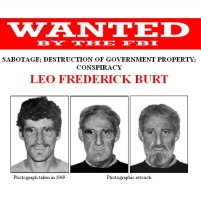The Anti-Vietnam War Bomber Who Got Away
Tuesday, August 24, 2010

Former college student Leo Burt is known as “Wisconsin’s state ghost.” But no one can prove that Burt is actually dead. The one-time radical who attended the University of Wisconsin four decades ago has been in hiding since he took part in what was the worst domestic terrorism attack until the 1993 World Trade Center bombing.
On August 24, 1970, Burt and three other radicals parked a stolen van packed with fertilizer and fuel outside the university’s Army Math Research Center in Sterling Hall. The Center had recently received a $1.8 million contract from the Department of Defense. The bomb was detonated in the middle of the night, killing 33-year-old graduate student Robert Fassnacht, who was doing research, and injuring three others.
The bombers fled to Canada, and three were caught eventually. Karl Armstrong and his younger brother, Dwight, came from a working class family on Madison’s East Side. Karl, considered the leader of the gang of four, was the first to be arrested—in Toronto on February 16, 1972. He served seven years in prison and now operates a juice stand in Madison.
Dwight, who was 18 years old at the time of the bombing, went into hiding for seven years, but was captured in Toronto in 1977. He served three years in prison for the crime and died of lung cancer in Madison on June 20 of this year. Today, on the fortieth anniversary of the bombing, some of his friends and family intend to drop his ashes off the cliffs of one of his favorite spots, Devil’s Lake State Park.
David Fine was also 18 when he and his companions bombed Sterling Hall. After six years as a fugitive, he was captured in San Rafael, California, on January 7, 1976, and spent three years in prison. After earning a law degree at the University of Oregon, he was denied admission to the Oregon bar because of his involvement in the bombing. He now works as a paralegal in Portland, Oregon.
And then there’s Leo Burt. After growing up in a middle-class Philadelphia family, he was recruited to join several university rowing teams, but chose Wisconsin because he thought its team was the best. But in his junior year he was dropped from the travelling squad because, at five feet eleven inches, he was too small. He joined the school newspaper, The Daily Cardinal, and while covering a confrontation between students and police after the killing of four students at Kent State University by members of the Ohio National Guard on May 4, 1970, the 22-year-old Burt was beaten by sheriff’s deputies. Then he joined the plot with Fine and the Armstrongs.
After the bombing, the four fled by car. When the news came on the radio that they had killed someone, Burt wept. He and Fine travelled by bus to New York City and then crossed into Canada, finding lodging in Petersborough. The next day, Royal Canadian Mounted Police showed up at the front door of their rooming house, and Burt and Fine fled through a back window. After parting from Fine, Burt vanished…and no one knows what has happened to him since. The FBI is still offering a $150,000 reward for his capture.
University of Wisconsin officials recently marked the anniversary of the bombing by opening a recording booth in the library, where people can share their memories of the attack for inclusion in the school’s archives and in a documentary. A small plaque honoring Fassnacht is the only permanent sign on campus that the bombing happened.
-David Wallechinsky
40 Years Later, Wis. Bomber Is a 'Ghost' (by Ryan J. Foley, Associated Press)
Sterling Hall Bombing: Seven Men Linked by a Moment in History (Wisconsin State Journal)
The Last Radical—Dead or Alive? (by Will Bunch, Philadelphia Daily News)
The Last Fugitive (by Doug Moe, On Wisconsin) (pdf)
Leo Frederick Burt (FBI)
- Top Stories
- Unusual News
- Where is the Money Going?
- Controversies
- U.S. and the World
- Appointments and Resignations
- Latest News
- Trump to Stop Deportations If…
- Trump Denounces World Series
- What If China Invaded the United States?
- Donald Trump Has a Mental Health Problem and It Has a Name
- Trump Goes on Renaming Frenzy






Comments